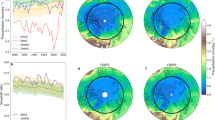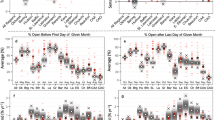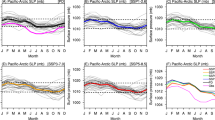Abstract
The Arctic is rapidly warming and experiencing tremendous changes in sea ice, ocean and terrestrial regions. Lack of long-term scientific observations makes it difficult to assess whether Arctic changes statistically represent a ‘new Arctic’ climate. Here we use five Coupled Model Intercomparison Project 5 class Earth system model large ensembles to show how the Arctic is transitioning from a dominantly frozen state and to quantify the nature and timing of an emerging new Arctic climate in sea ice, air temperatures and precipitation phase (rain versus snow). Our results suggest that Arctic climate has already emerged in sea ice. Air temperatures will emerge under the representative concentration pathway 8.5 scenario in the early- to mid-twenty-first century, followed by precipitation-phase changes. Despite differences in mean state and forced response, these models show striking similarities in their anthropogenically forced emergence from internal variability in Arctic sea ice, surface temperatures and precipitation-phase changes.
This is a preview of subscription content, access via your institution
Access options
Access Nature and 54 other Nature Portfolio journals
Get Nature+, our best-value online-access subscription
$29.99 / 30 days
cancel any time
Subscribe to this journal
Receive 12 print issues and online access
$209.00 per year
only $17.42 per issue
Buy this article
- Purchase on Springer Link
- Instant access to full article PDF
Prices may be subject to local taxes which are calculated during checkout




Similar content being viewed by others
Data availability
All data used in this study are publicly available. CMIP5-MMLE output are available through the MMLEA (US CLIVAR Multi-Model LE Archive (NCAR); http://www.cesm.ucar.edu/projects/community-projects/MMLEA/). The Walsh extended and NSIDC SICs are available online (https://nsidc.org/).
Code availability
Code to produce all figures is available from the corresponding author.
References
Box, J. E. et al. Key indicators of Arctic climate change: 1971–2017. Environ. Res. Lett. 14, 045010 (2017).
Hansen, J., Ruedy, R., Sato, M. & Lo, K. Global surface temperature change. Rev. Geophys. 48, RG4004 (2010).
Serreze, M. C. & Barry, R. G. Processes and impacts of Arctic amplification: a research synthesis. Glob. Planet. Change 77, 85–96 (2011).
Screen, J. A. & Simmonds, I. I. The central role of diminishing sea ice in recent Arctic temperature amplification. Nature 464, 1334–1337 (2010).
Fetterer, F., Knowles, K., Meier, W. N., Savoie, M. & Windnagel, A. K. Sea Ice Index, Version 3 (Northern Hemisphere monthly) (NSIDC, accessed 22 April 2020); https://doi.org/10.7265/N5K072F8
Graham, R. et al. Increasing frequency and duration of Arctic winter warming events. Geophys. Res. Lett. 44, 6974–6983 (2017).
Moore, G. W. K. The December 2015 North Pole warming event and the increasing occurrence of such events. Nat. Sci. Rep. 6, 39084 (2016).
Rinke, A. et al. Extreme cyclone events in the Arctic: Wintertime variability and trends. Environ. Res. Lett. 12, 094006 (2017).
Cohen, J., H. Ye, H. & Jones, J. Trends and variability in rain-on-snow events. Geophys. Res. Lett. 42, 7115–7122 (2015).
Hansen, B. B., Aanes, R., Herfindal, I., Kohler, J. & Sæther, B.-E. Climate, icing, and wild Arctic reindeer: past relationships and future prospects. Ecology 92, 1917–1923 (2011).
Rennert, K., Roe, G., Putkonen, J. & Bitz, C. M. Soil thermal and ecological impacts of rain on snow events in the circumpolar Arctic. J. Clim. 22, 2302–2315 (2008).
Stien, A. et al. Congruent responses to weather variability in high Arctic herbivores. Biol. Lett. 8, 1002–1005 (2012).
Beaumont, L. J. et al. Impacts of climate change on the world’s most exceptional ecoregions. Proc. Natl Acad. Sci. USA 108, 2306–2311 (2011).
Giorgi, F. & Bi, X. Time of emergence (TOE) of GHG forced precipitation change hot-spots. Geophys. Res. Lett. 36, L06709 (2009).
Haine, T. W. & Martin, T. The Arctic–Subarctic sea ice system is entering a seasonal regime: implications for future Arctic amplification. Sci. Rep. 7, 4618 (2017).
King, A. D. et al. The timing of anthropogenic emergence in simulated climate extremes. Environ. Res. Lett. 10, 094015 (2015).
Lehner, F., Deser, C. & Terray, L. Toward a new estimate of “time of emergence” of anthropogenic warming: insights from dynamical adjustment and a large initial-condition model ensemble. J. Clim. 30, 7739–7756 (2017).
Mahlstein, I., Heger, G. & Solomon, S. Emerging local warming signals in observational data. Geophys. Res. Lett. 39, L21711 (2012).
Barnhart, K. R., Miller, C. R., Overeem, I. & Kay, J. E. Mapping the future expansion of Arctic open water. Nat. Clim. Change 6, 280–285 (2016).
Moon, T. A. et al. The expanding footprint of rapid Arctic change. Earths Future 7, 212–218 (2019).
Hegerl, G. C., Brönnimann, S., Schurer, A. & Cowan, T. The early 20th century warming: anomalies, causes, and consequences. Wiley Interdiscip. Rev. Clim. Change 9, e522 (2018).
Tokinaga, H., Xie, S. P. & Mukougawa, H. Early 20th-century Arctic warming intensified by Pacific and Atlantic multidecadal variability. Proc. Natl Acad. Sci. USA 114, 6227–6232 (2017).
Walsh, J. E., Fetterer, F., Stewart, J. Scott & Chapman, W. L. A database for depicting Arctic sea ice variations back to 1850. Geographical Rev. 107, 89–107 (2016).
Brönnimann, S. et al. A multi‐data set comparison of the vertical structure of temperature variability and change over the Arctic during the past 100 years. Clim. Dyn. 39, 1577–1598 (2012).
Cowtan, K. & Way, R. G. Coverage bias in the HadCRUT4 temperature series and its impact on recent temperature trends. Q. J. R. Meteorol. Soc. 140, 1935–1944 (2014).
Deser, C. et al. Insights from Earth system model initial-condition large ensembles and future prospects. Nat. Clim. Change https://doi.org/10.1038/s41558-020-0731-2 (2020).
Dai, A., Luo, D., Song, M. & Liu, J. Arctic amplification is caused by sea-ice loss under increasing CO2. Nat. Commun. 10, 121 (2019).
Hall, A. The role of surface albedo feedback in climate. J. Clim. 17, 1550–1568 (2004).
Holland, M. M. & Bitz, C. M. Polar amplification of climate change in coupled models. Clim. Dyn. 21, 221–232 (2003).
Kumar, A. et al. Contribution of sea ice loss to Arctic amplification. Geophys. Res. Lett. https://doi.org/10.1029/2010GL045022 (2010).
Labe, Z. M., Peings, Y. & Magnusdottir, G. Contributions of ice thickness to the atmospheric response from projected Arctic sea ice loss. Geophys. Res. Lett. https://doi.org/10.1029/2018GL078158 (2018).
Lang, A., Yang, S. & Kaas, E. Sea ice thickness and recent Arctic warming. Geophys. Res. Lett. 44, 409–418 (2017).
Pithan, F. & Mauritsen, T. Arctic amplification dominated by temperature feedbacks in contemporary climate models. Nat. Geosci. 7, 181–184 (2014).
Screen, J. A., Simmonds, I., Deser, C. & Tomas, R. The atmospheric response to three decades of observed Arctic sea ice loss. J. Clim. 26, 1230–1248 (2013).
Screen, J. A. et al. Consistency and discrepancy in the atmospheric response to Arctic sea-ice loss across climate models. Nat. Geosci. 11, 155–163 (2018).
Serreze, M. C., Barrett, A. P., Stroeve, J. C., Kindig, D. N. & Holland, M. M. The emergence of surface-based Arctic amplification. Cryosphere 3, 11–19 (2009).
Smith, D. M. et al. The Polar Amplification Model Intercomparison Project (PAMIP) contribution to CMIP6: investigating the causes and consequences of polar amplification. Geosci. Model Dev. 12, 1139–1164 (2019).
Sun, L. et al. Drivers of 2016 record Arctic warmth assessed using climate simulations subjected to factual and counterfactual forcing. Weather Clim. Extrem. https://doi.org/10.1016/j.wace.2017.11.001 (2018).
Holland, M. M., Bitz, C. M., Tremblay, B. & Bailey, D. A. in Arctic Sea Ice Decline: Observations, Projections, Mechanisms, and Implications (eds DeWeaver, E. T. et al.) 133–150 (AGU, 2008).
Goosse, H., Arzel, O., Bitz, C. M., de Montety, A. & Vancoppenolle, M. Increased variability of the Arctic summer ice extent in a warmer climate. Geophys. Res. Lett. 36, L23702 (2009).
Mioduszewski, J., Vavrus, S., Wang, M., Holland, M. & Landrum, L. Future interannual variability of Arctic sea ice in coupled climate models. Cryosphere 13, 113–124 (2018).
Meinshausen, M. et al. The RCP greenhouse gas concentrations and their extension from 1765 to 2300. Climatic Change 109, 213–241 (2011).
Liu, J., Song, M., Horton, R. M. & Hu, Y. Reducing spread in projected ice-free Arctic. Proc. Natl Acad. Sci. USA https://doi.org/10.1073/pnas.1219716110 (2013).
Massonnet, F. et al. Constraining projections of summer Arctic sea ice. Cryosphere Discuss. 6, 2931–2959 (2012).
Overland, J. E. & Wang, M. When will the summer Arctic be nearly sea ice free. Geophys. Res. Lett. 40, 2097–2101 (2013).
Wang, M. & Overland, J. E. Projected future duration of the sea-ice-free season in the Alaskan Arctic. Prog. Oceanogr. 136, 50–59 (2015).
Jahn, A. Reduced probability of ice-free summers for 1.5 °C compared to 2 °C warming. Nat. Clim. Change 8, 409–413 (2018).
Screen, J. A. & Williamson, D. Ice-free Arctic at 1.5 °C? Nat. Clim. Change 7, 230–231 (2017).
Sigmond, M., Fyfe, J. C. & Swart, N. C. Ice-free Arctic projections under the Paris Agreement. Nat. Clim. Change 8, 404–408 (2018).
Blüthgen, J., R. Gerdes, R. & Werner, M. Atmospheric response to the extreme Arctic sea ice conditions in 2007. Geophys. Res. Lett. https://doi.org/10.1029/2011GL050486 (2012).
Francis, J. A., Chan, W., Leathers, D. J., Miller, J. R. & Veron, D. Winter Northern Hemisphere weather patterns remember summer Arctic sea-ice extent. Geophys. Res. Lett. 36, L07503 (2009).
Francis, J. A. & Vavrus, S. J. Evidence linking Arctic amplification to extreme weather in mid‐latitudes. Geophys. Res. Lett. 39, LO6801 (2012).
Jaiser R., Dethloff, K., Handorf, D., Rinke, A. & Cohen, J. Impact of sea ice cover changes on the Northern Hemisphere atmospheric winter circulation. Tellus A https://doi.org/10.3402/tellusa.v64i0.11595 (2012).
Maykut, G. A. & Untersteiner, N. Some results from a time-dependent thermodynamic model of sea ice. J. Geophys. Res. 76, 1550–1575 (1972).
Deser, C., Tomas, R., Alexander, M. & Lawrence, D. The seasonal atmospheric response to projected Arctic sea ice loss in the late 21st century. J. Clim. 23, 333–351 (2010).
Bintanja, R. & van der Linden, E. C. The changing seasonal climate in the Arctic. Sci. Rep. https://doi.org/10.1038/srep01556 (2012).
Screen, J. A. Arctic amplification decreases temperature variance in northern mid- to high-latitudes. Nat. Clim. Change 4, 577–582 (2014).
Dee, D. P. et al. The ERA-Interim reanalysis: configuration and performance of the data assimilation system. Q. J. R. Meteorol. Soc. 137, 553–597 (2011).
Rhines, A., McKinnon, K. A., Tingley, M. P. & Huybers, P. Seasonally resolved distributional trends of North American temperatures show contraction of winter variability. J. Clim. 30, 1139–1157 (2017).
Pan, C. G., Kirchner P. B., Kimball, J. S., Kim, Y. & Du, J. Rain-on-snow events in Alaska, their frequency and distribution from satellite observations. Environ. Res. Lett. https://doi.org/10.1088/1748-9326/aac9d3 (2018).
Ye, H. Changes in frequency of precipitation types associated with surface air temperature over northern Eurasia during 1936–90. J. Clim. 29, 729–734 (2008).
Callaghan, T. V. et al. Multiple effects on changes in Arctic snow cover. Ambio 40, 32–45 (2011).
Conway, H. & Raymond, C. F. Snow stability during rain. J. Glaciol. 39, 635–642 (1993).
McCabe, G. J., Clark, M. P. & Hay, L. E. Rain‐on‐snow events in the western United States. Bull. Am. Meteorol. Soc. 88, 319–328 (2007).
Putkonen, J. & G. Roe, G. Rain‐on‐snow events impact soil temperatures and affect ungulate survival. Geophys. Res. Lett. 30, 1188 (2003).
Ye, H. & Cohen, J. Shorter snowfall season associated with higher air temperatures over northern Eurasia. Environ. Res. Lett. 8, 014052 (2013).
Hansen, B. B. et al. Warmer and wetter winters: characteristics and implications of an extreme weather event in the high Arctic. Environ. Res. Lett. 9, 114021 (2014).
Kirchmeier-Young, M. C., Zwiers, F. W. & Gillett, N. P. Attribution of extreme events in Arctic sea ice extent. J. Clim. 30, 553–571 (2017).
Kay, J. E. et al. The Community Earth System Model (CESM) Large Ensemble project: a community resource for studying climate change in the presence of internal climate variability. Bull. Am. Meteorol. Soc. 96, 1333–1349 (2015).
Sun, L., Alexander, M. & Deser, C. Evolution of the global coupled climate response to Arctic sea ice loss during 1990–2090 and its contribution to climate change. J. Clim. 31, 7823–7843 (2018).
Rodgers, K. B., Lin, J. & Frölicher, T. L. Emergence of multiple ocean ecosystem drivers in a large ensemble suite with an Earth system model. Biogeosciences 12, 3301–3320 (2015).
Maher, N. et al. The max planck institute grand ensemble—enabling the exploration of climate system variability. J. Adv. Model. Earth Syst. 11, 2050–2069 (2019).
Arguez, A. & Vose, R. S. The definition of the standard WMO climate normal: the key to deriving alternative climate normals. Bull. Am. Meteorol. Soc. https://doi.org/10.1175/2010BAMS2955.1 (2011).
Labe, Z., Magnusdottir, G. & Stern, H. Variability of Arctic sea ice thickness using PIOMAS and the CESM large ensemble. J. Clim. 31, 3233–3247 (2018).
Randall, D. A. et al. in Climate Change 2007: The Physical Science Basis (eds Solomon, S. et al.) Ch. 8 (Cambridge Univ. Press, 2007).
Rosenblum, E. & Eisenman, I. Sea ice trends in climate models only accurate runs with biased global warming. J. Clim. 30, 6265–6278 (2017).
Stroeve, J. & Notz, D. Insights on past and future sea-ice evolution from combining observations and models. Glob. Planet. Change 135, 119–132 (2015).
Kinnard, C. M. et al. Reconstructed changes in Arctic sea ice over the past 1,450 years. Nature 479, 509–512 (2011).
Soulé, P. T. & Knapp, P. A. A 400-year reconstruction of wintertime Arctic sea-ice extent using a high-elevation, mid-latitude tree-ring record. Int. J. Biometeorol. 63, 1217–1229 (2019).
The NCAR Command Language v.6.6.2 (UCAR, NCAR, CISL and TDD, 2019); https://doi.org/10.5065/D6WD3XH5
Landrum, L. Scripts for figures and analysis for “Extremes become routine in an emerging new Arctic”. Zenodo https://doi.org/10.5281/zenodo.3942733 (2020).
Walsh, J. E., Chapman, W. L., Fetterer, F. & Stewart, J. S. Gridded Monthly Sea Ice Extent and Concentration, 1850 Onward, Version 2 (NSIDC, accessed 23 April 2020); https://doi.org/10.7265/jj4s-tq79
Acknowledgements
We acknowledge support from a grant from the NOAA Climate Program Office Grant NA15OAR4310166 and NSF Grant 1724748. We acknowledge the CESM Large Ensemble Community Project and high-performance computing support from both Yellowstone (ark:/85065/d7wd3xhc) and Cheyenne (https://doi.org/10.5065/D6RX99HX) provided by NCAR’s Computational and Information Systems Laboratory, sponsored by the National Science Foundation. We thank the US National Science Foundation, National Oceanic and Atmospheric Administration, National Aeronautics and Space Administration, and Department of Energy for sponsoring the activities of the US CLIVAR Working Group on Large Ensembles. We also gratefully acknowledge all of the modelling groups listed in Table 1 for making their Large Ensemble simulations available in the Multi-Model Large Ensemble data repository.
Author information
Authors and Affiliations
Contributions
L.L. and M.M.H. conceived the study. L.L. performed the analysis, created the figures and led the writing of the manuscript with contributions from M.M.H.
Corresponding author
Ethics declarations
Competing interests
The authors declare no competing interests.
Additional information
Peer review information Nature Climate Change thanks John Walsh and the other, anonymous, reviewer(s) for their contribution to the peer review of this work.
Publisher’s note Springer Nature remains neutral with regard to jurisdictional claims in published maps and institutional affiliations.
Extended data
Extended Data Fig. 1 CMIP5-MMLE NH SIE monthly climatology for 5 decades.
Dashed/dotted lines indicate (1979–1988)/(2010-2019) monthly decadal averages from the NSIDC ice index5. Solid grey line indicates the 1 million km2 ‘Ice Free’ definition.
Extended Data Fig. 2 CMIP5-MMLE and observational based Arctic Sea Ice extents.
Bold solid lines indicate ensemble mean, with opaque polygon showing range of simulations for each ensemble. Extended Sea Ice dataset82 and NSIDC ice index5 are shown in solid dark and light grey, respectively. Insets show PDFs for running 20 yr trends over the 20th Century for each model for both minimum and maximum SIEs.
Extended Data Fig. 3 CMIP5-MMLE Time of Emergence of monthly October and February surface air temperatures.
October/February ToEs are shown in the left/right panels.
Extended Data Fig. 4 CMIP5-MMLE mean October surface air temperature changes from (1950-1959) baseline.
Results shown for early, middle and late 21st century under RCP8.5 forcing scenario. Contours indicate September 15% sea ice concentration contours for base period (1950-1959; black) and future decades (white).
Extended Data Fig. 5 CMIP5-MMLE mean February surface air temperature changes from (1950-1959) baseline.
Results shown for early, middle and late 21st century under RCP8.5 forcing scenario. Contours indicate February 15% and 85% sea ice concentration contours for base period (1950-1959; 15% black) and future decades (15% white, 85% grey).
Extended Data Fig. 6 CMIP5-MMLE first rain day changes from (1950-1959) baseline.
Results shown for early, middle and late 21st century under RCP8.5 forcing scenario.
Extended Data Fig. 7 CMIP5-MMLE last rain day changes from (1950-1959) baseline.
Results shown for early, middle and late 21st century under RCP8.5 forcing scenario.
Extended Data Fig. 8 CMIP5-MMLE rain season duration from (1950-1959) baseline.
Results shown for early, middle and late 21st century under RCP8.5 forcing scenario.
Supplementary information
Supplementary Information
Supplementary Fig. 1, discussion and Table 1.
Rights and permissions
About this article
Cite this article
Landrum, L., Holland, M.M. Extremes become routine in an emerging new Arctic. Nat. Clim. Chang. 10, 1108–1115 (2020). https://doi.org/10.1038/s41558-020-0892-z
Received:
Accepted:
Published:
Issue Date:
DOI: https://doi.org/10.1038/s41558-020-0892-z
This article is cited by
-
Projections of an ice-free Arctic Ocean
Nature Reviews Earth & Environment (2024)
-
Detecting climate signals cascading through levels of biological organization
Nature Climate Change (2023)
-
Wind influences the onset of a seasonally sea-ice-free Arctic
Nature Climate Change (2023)
-
Seasonal and regional contrasts of future trends in interannual arctic climate variability
Climate Dynamics (2023)
-
Recent upper Arctic Ocean warming expedited by summertime atmospheric processes
Nature Communications (2022)



